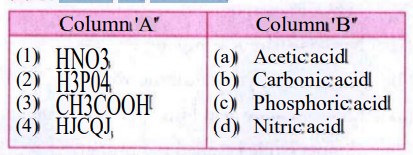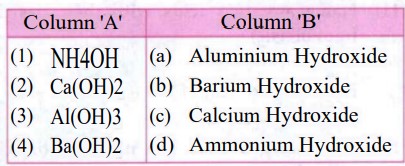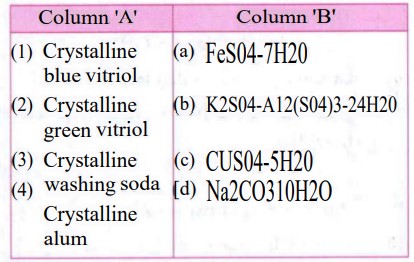Complete Solutions to EXAMPLE of chapter Acid, Bases and Salts of Class 9 book with complete answers and questions
| Class 9 | CHEMISTRY |
| Chapter | Acid, Bases and Salts |
| CHETANA PUBLICATION | EXAMPLE |
| Number Of Questions | 68 |
| Academic Year | 2023-24 |
How are the following substances classified into three groups with the help of litmus? Lemon, tamarind, baking soda, buttermilk, vinegar, orange, milk, lime, tomato, milk of magnesia, water, alum.
View Solution…………………..acid is present in lemon.
View SolutionTamarind contains……………….. Add.
View SolutionButter milk contains……………………acid.
View SolutionIf the basic radical is H+ the type of compound is……………………
View SolutionThe name of compound NH, is……………….
View SolutionThe bases which are soluble in water are called as
View SolutionH3P04 is a………… acid.
View SolutionAccording to pH scale pure water has a pH of……………
View SolutionWith reference to neutralization, metallic oxides are…………….. In nature
View SolutionMolecular formula of blue vitriol is………………………
View SolutionMolecular formula of crystalline alum is………………
View SolutionMolecular formula for sodium oxide is…………………
View SolutionH2C03 is……………….. Acid..
View SolutionMolecular formula of Red oxide is………………..
View SolutionThe positive terminal electrode is called as
View Solution………………….produced in stomach helps in digestion.
View SolutionThe solution turns blue litmus red, its pH is likely to be………………….,
View SolutionAn ionic compound NaCl is formed by………………..
View SolutionpH of strong acid is………………
View SolutionAdding water to arid is an………… reaction.
View SolutionFind the odd one out:
Chloride, Nitrate, Hydride, Ammonium
View SolutionFind the odd one out:
Hydrogen chloride, Sodium hydroxide, Calcium oxide, Ammonia
View SolutionFind the odd one out:
Acetic arid, Carbonic arid, Hydrochloric acid, Nitric ari
View SolutionFind the odd one out:
Sodium nitrate, Sodium carbonate, Sodium sulphate, Sodium chloride
View SolutionFind the odd one out:
Calcium oxide, Magnesium oxide, Zinc oxide, Sodium oxid
View SolutionFind the odd one out:
Sodium chloride, Potassium chloride, Acetic acid, Sodium aceta
View SolutionFind the odd one out:
Lime water, Vinegar, Acetic acid, Tartaric acid
View SolutionFind the odd one out:
Crystalline, Liquid, Gases, Solid.
View SolutionName the three types of ionic compounds.
View SolutionName the two constituents of molecule of an ionic compound.
View SolutionName any three acids with their molecular formula.
View SolutionName any three bases with their molecular formula.
View SolutionName any three salts with their molecular formula.
View SolutionName any two strong acids.
View SolutionName any two weak acids.
View SolutionName any two strong bases.
View SolutionName a weak base.
View SolutionName any two alkalis.
View SolutionName any two acids with their basicity 1 (monobasic)
View SolutionName any two acids with their basicity 2 (dibasic)
View SolutionName any two acids with their basicity 3 (tribasic)
View SolutionName any two bases with their acidity 1 (monoacidic)
View SolutionName any two bases with their acidity 2 (diacidic)
View SolutionName any two bases with their acidity 3 (triaddic)
View SolutionName the two units to express the concentration of the solution.
View SolutionMatch the columns:

View SolutionMatch the columns:

View SolutionMatch the columns:

View SolutionState whether the following statements are true or false and if false. Correct the false statement:
H2S04 is a strong acid.
View SolutionDefine the following:
Basicity of acids
View SolutionDefine the following:
Acidity of bases
View SolutionDefine the following:
Concentration of solute in the solution.
View SolutionDefine the following:
Dilute solution
View SolutionDefine the following:
Neutralization
View SolutionDefine the following:
Cathode
View SolutionDefine the following:
Anode
View SolutionDefine the following:
Cations
View SolutionDefine the following:
Anions
View SolutionDefine the following:
Electrolytic cell
View SolutionDefine the following:
Molarity of solution
View SolutionDefine the following:
Acid- base indicators
View SolutionWhen ferric oxide reacts with diluted hydrochloric acid.
View SolutionWhen calcium oxide reacts with dilute hydrochloric acid.
View SolutionWhen aluminium oxide reacts with hydrogen fluoride
View SolutionWhen carbon dioxide reacts with potassium hydroxide.
View SolutionWhen calcium hydroxide reacts with carbon dioxide.
View SolutionExplain Arrhenius theory of acids and ba
View Solution
EXAMPLE questions and complete solutions for chapter Acid, Bases and Salts of CHETANA PUBLICATION of Class 9